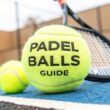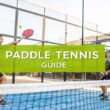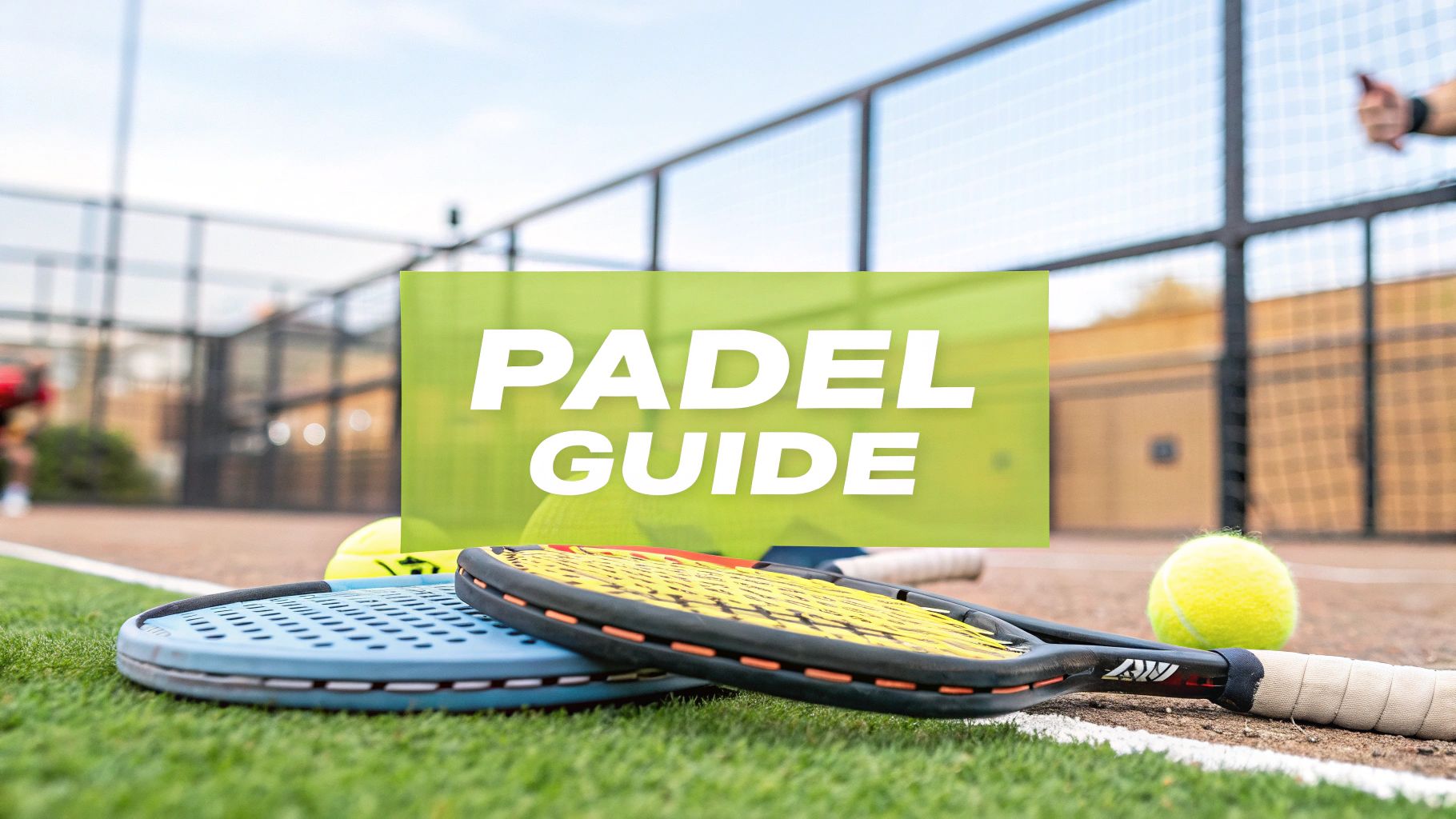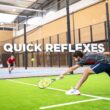Walk into any sports club these days, and you'll probably hear a sound you can't quite place. It's the rhythmic thwack of a ball, mixed with laughter and the satisfying thud of a ball hitting glass. Welcome to the world of padel.
So, what is this sport that has everyone hooked? Think of it as the lovechild of tennis and squash. It's played in doubles on a court that's enclosed by glass and mesh, which brings an entirely new dimension to the game.
What Is Padel and Why Is Everyone Playing It?
Imagine the back-and-forth volleys of tennis, but now add the wild-card element of playing shots off the back and side walls, just like in squash. That’s the core of padel. The court itself is about 25% smaller than a tennis court, which keeps the action fast, furious, and right in your face. This smaller space and the wall-play lead to some seriously long and exciting rallies, even for total beginners.
A huge part of its charm is how easy it is to get started. Forget spending months trying to master a powerful tennis serve. In padel, you serve underhand. It's simple, intuitive, and gets you into a proper rally from your very first game. This is why it's taken the world by storm—you’re not bogged down by a steep learning curve. You’re having a blast and playing real points within the first hour. That immediate fun factor is what keeps people coming back.
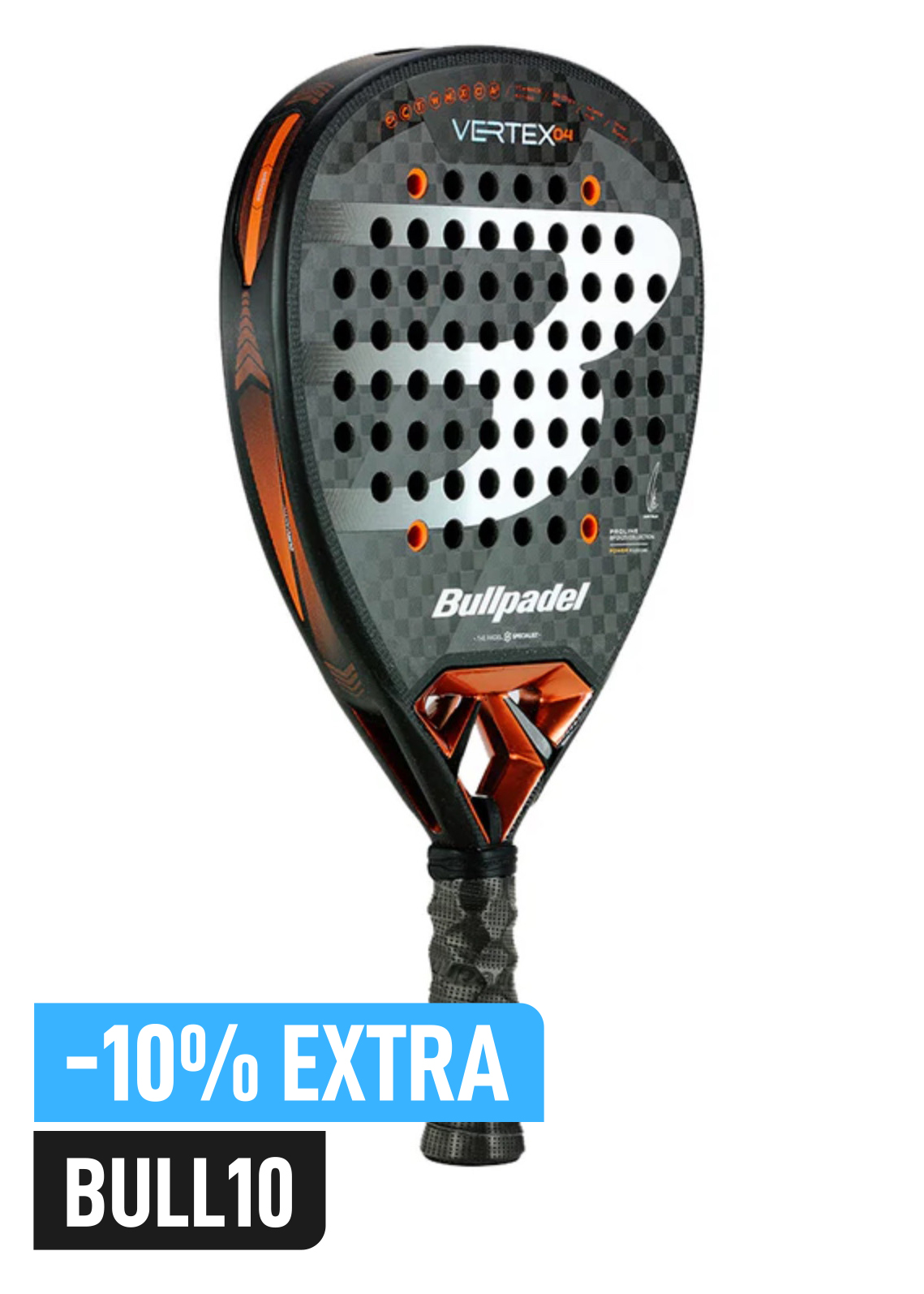
Buy the best padel gear to level up your next game!
CHECK OUT this deal from Padel Market!Get ready to take your game to the next level with the latest padel gear from Padel Market! Fast EU and Worldwide Shipping
An Unstoppable Global Phenomenon
The hype isn't just talk; the numbers are staggering. Padel's growth is a global tidal wave. In just one recent year, over 7,000 new courts popped up worldwide, pushing the total past 50,000. We also saw 3,282 new clubs open—a massive 26% increase in a single year. That’s like nine new clubs opening their doors every single day!
While powerhouse countries like Spain and Sweden keep building, the sport is exploding in new places from Lithuania to Tunisia. For a deeper dive into the data, the 2025 Playtomic Report paints a wild picture of this expansion.
Padel’s secret sauce is its perfect balance. It’s simple enough for anyone to learn in an afternoon but has enough strategic depth and nuance to keep you hooked for a lifetime.
More Than Just a Game
Beyond the rules and the rallies, the social scene is arguably the biggest draw. Padel is a doubles-only game, so it's all about communication and teamwork. Clubs are turning into genuine community hubs where meeting new people and finding partners is all part of the experience. It’s a sport that truly brings people together, no matter their age or fitness level.
So, why are so many people falling in love with padel?
- It’s incredibly social. The doubles format and friendly club vibe make it an amazing way to connect with friends, old and new.
- It's easy to learn. The rules are straightforward, and the racket is forgiving. You'll be enjoying proper rallies right away.
- It’s a fantastic workout. The game is fast-paced and gets your heart pumping, but it’s much kinder on the joints than other racket sports.
- It’s strategically deep. Easy to start, but mastering the angles, wall plays, and court positioning is a challenge that never gets old.
From its quiet beginnings in Acapulco, Mexico, way back in 1969, padel has grown into a true global sensation. This guide is your all-access pass. We'll cover everything from the basic rules and gear to the advanced techniques that will have you playing with confidence. Let's get you on the court.
The Court Rules and Scoring System Explained
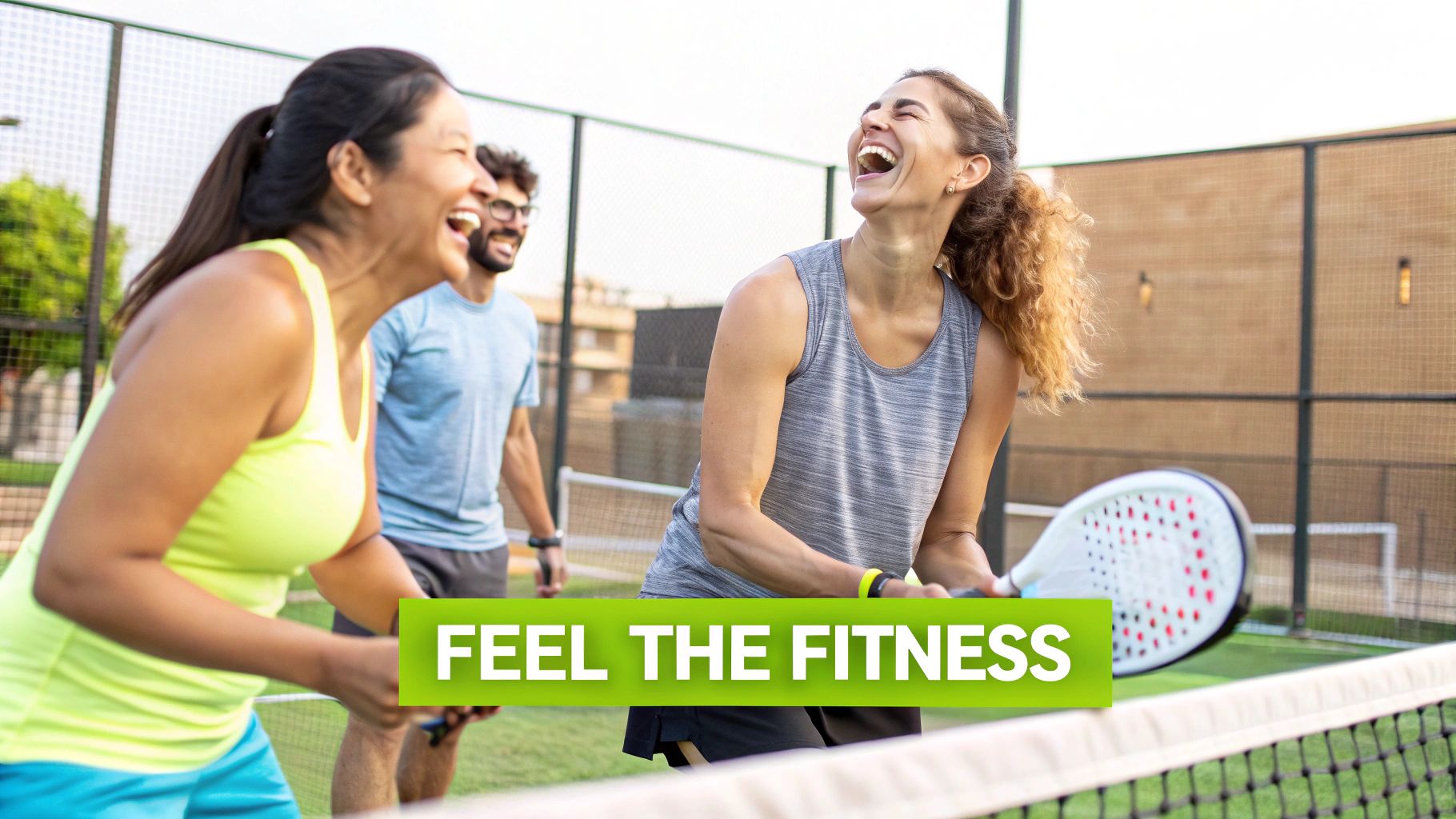
Jumping into any new sport can feel a bit overwhelming, but one of the absolute best things about padel is just how fast the rules make sense. The court might look like a high-tech tennis arena, but its design is the secret to the game’s incredibly fun and dynamic flow. The key is to think of the walls not as boundaries, but as active players in every single point.
The court itself is a tidy, enclosed rectangle, noticeably smaller than a tennis court at 10 meters wide by 20 meters long. It’s boxed in by a mix of glass walls at the back and sides, with wire mesh fencing finishing off the enclosure. This very setup is what leads to the long, heart-pumping rallies that padel is famous for, as the ball stays in play for much longer.
Understanding The Padel Scoring System
Got any experience with tennis? If so, you're already ahead of the game because you know how to keep score in padel. The system is identical, which gives new players a really familiar starting point. Points follow the classic progression from Love (zero) to 15, 30, and 40.
- 15: The first point your team wins.
- 30: The second point you secure.
- 40: The third point won.
- Game: Bagging the fourth point wins you the game.
If both teams fight their way to 40-40, we call it deuce. From here, a team needs to win two points in a row to clinch the game. Win the first point after deuce, and you have the advantage. If your team wins the next point, the game is yours. But if you lose it, the score snaps right back to deuce. This back-and-forth continues until one team pulls ahead by two clear points.
To keep matches moving, many clubs and tournaments now use the "Golden Point." When the score hits deuce, the receiving team gets to choose which side (left or right) will take the serve. Whoever wins that single, high-stakes rally wins the game.
Core Rules Of Gameplay
Aside from the score, a few basic rules dictate how every point unfolds. Nailing these is your first real step toward playing with confidence. The most important rule to learn right away is the serve—unlike tennis, it has to be hit underhand.
The Serve:
- The server has to stand behind the service line.
- You must bounce the ball on the ground one time before you hit it.
- Your contact with the ball must be at or below waist level.
- The serve has to fly diagonally into your opponent's service box and bounce there first to be legal.
If your serve nicks the net but still lands in the correct service box, it’s a let, and you get to replay the serve. But if it hits the net and lands outside the box, that’s a fault. Just like in tennis, you get two attempts to get your serve in.
Playing The Ball And Using The Walls
Once the serve is in, the rally is on. This is where a huge difference from tennis comes into play: using the walls. You are allowed to hit the ball after it has bounced off one of the glass walls on your side. This is a go-to defensive move that buys you precious time to set up your return shot.

Buy the best padel gear to level up your next game!
CHECK OUT this deal from Padel Market!Get ready to take your game to the next level with the latest padel gear from Padel Market! Fast EU and Worldwide Shipping
A shot is good if:
- You hit the ball directly over the net, it bounces once on your opponent's court, and then hits a wall.
- You let the ball bounce once on your side, rebound off a side or back wall, and then you hit it back over.
You’ll lose the point, however, if the ball smacks the wire mesh fence before it bounces on the ground. For a complete deep dive, you can learn more about the complete rules of padel in this detailed guide. Getting a feel for these little details is what will transform you from just hitting the ball to playing with real strategy. The walls are your best friend—start using them to your advantage.
How To Choose Your Padel Equipment
Diving into padel is a blast, but figuring out the gear can feel a bit overwhelming at first. The good news? You only really need three things to get on the court: a racket, some balls, and the right pair of shoes. Nailing these choices from the start will do more than just help your game—it'll keep you comfortable and playing injury-free.
Your padel racket, or pala as it’s often called, is by far the most important tool in your bag. Unlike tennis rackets with strings, these are solid paddles built with a foam core and a composite shell. The biggest decision you'll make is about its shape, because that single factor completely changes how the racket feels and performs.
Selecting The Perfect Padel Racket
The shape of a racket head isn't just for looks; it dictates where the "sweet spot" is and how the weight is balanced. This, in turn, decides if the racket is a control-oriented tool or a power-hitter's dream. The right one for you comes down to your experience level and what you're trying to accomplish in a match.
You'll find three main shapes out there:
- Round Rackets: These are the go-to for beginners, and for good reason. The sweet spot is huge and sits right in the middle, making it incredibly forgiving when you don't hit the ball perfectly. This design gives you maximum control, helping you put the ball exactly where you want it to go.
- Diamond Rackets: Built for advanced players, diamond rackets shift the sweet spot and balance towards the top of the head. This top-heavy feel generates some serious power for smashes, but it demands precise technique. The sweet spot is smaller, so it's much less forgiving if you're off your game.
- Teardrop Rackets: As the name suggests, this is a hybrid shape that offers a fantastic middle ground. It balances power and control beautifully, making it a favorite among intermediate players who’ve got their technique down but want a bit more oomph behind their shots.
Looking at all the different models can be confusing, which is why we put together a detailed guide on choosing the best padel racket to help you find the perfect fit.
The table below breaks down how each racket shape affects your game, making it easier to see the trade-offs between pure control and raw power.
Padel Racket Shape Comparison
| Racket Shape | Best For | Main Advantage | Main Disadvantage |
|---|---|---|---|
| Round | Beginners | Maximum control and a large, forgiving sweet spot. | Lacks top-end power for aggressive smashes. |
| Teardrop | Intermediate Players | A versatile blend of power and control. | Not as powerful as a diamond, not as forgiving as a round. |
| Diamond | Advanced Players | Generates explosive power for attacking shots. | Small, unforgiving sweet spot that requires precise technique. |
Ultimately, choosing a racket is a personal journey that evolves with your skill.
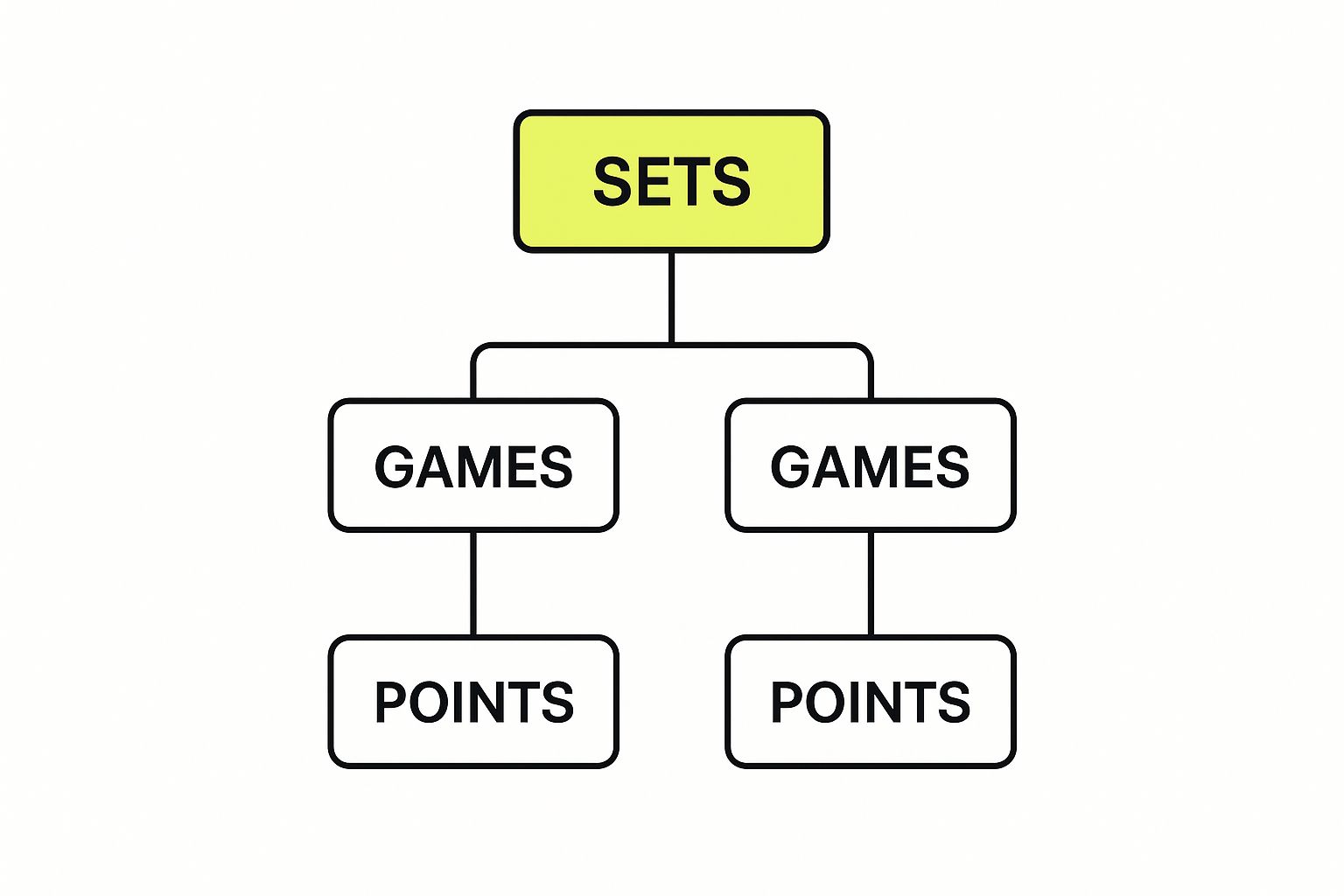
On top of the shape, materials matter. A racket with a fiberglass surface is softer and more flexible, which gives beginners extra comfort and easy power without having to swing out of their shoes. On the other hand, carbon fiber rackets are much stiffer and more durable, offering the crisp feel and precision that experienced players need to control the ball.
Choosing The Right Balls And Shoes
Once your racket is sorted, the next piece of the puzzle is the ball. They might look identical to tennis balls, but there’s a critical difference: padel balls have lower internal pressure. This makes them slightly softer and gives them a much less aggressive bounce.
Using proper padel balls isn't just a suggestion—it's essential. A bouncy tennis ball would ricochet wildly off the glass walls, making it almost impossible to hold a rally. Always look for cans that specifically say "padel" to make sure you have the right equipment for the game.
Finally, let's talk about what's on your feet. You can probably get by with regular tennis shoes for your first few hits, but buying a pair of dedicated padel shoes is one of the smartest investments you can make. The artificial turf and sand on a padel court demand a very specific kind of grip that your running shoes just can't provide.
Padel shoe soles generally come in two flavors:
- Herringbone Sole: This classic zig-zag pattern provides fantastic grip for the constant stopping and pivoting you do in padel. It's especially good on courts with a visible layer of sand.
- Omni Sole: This pattern uses smaller nubs and dimples for excellent traction during lateral and twisting movements. It’s a great all-around choice that works well on most court surfaces.
The right shoes aren't just about performance; they're a huge part of injury prevention. The stability and specialized grip patterns are engineered to protect your ankles and knees from the strain of all those quick changes in direction, letting you play harder and with more confidence.
Mastering The Fundamental Padel Techniques
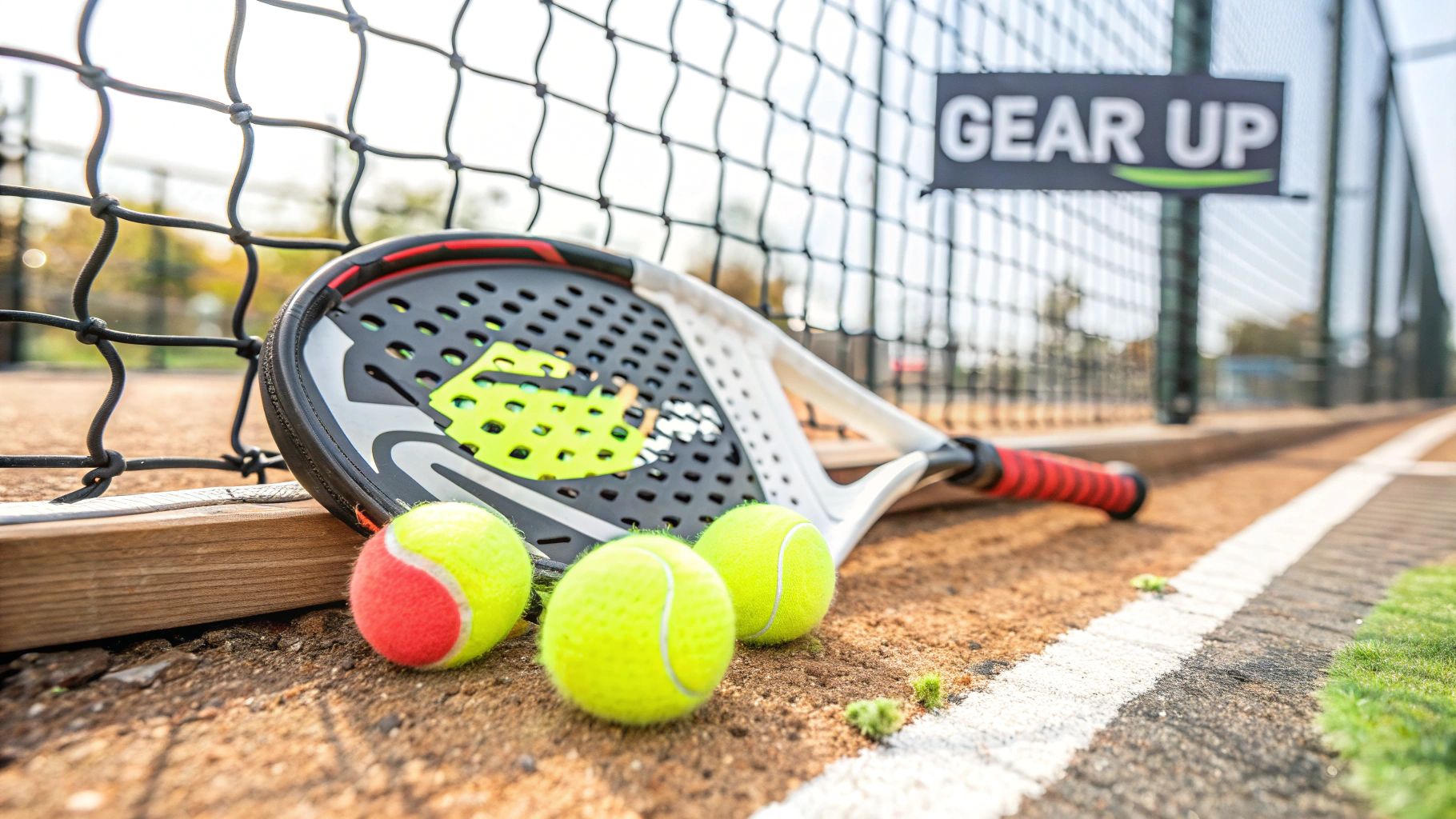
Once you've got the right gear in hand, it's time to start building your shot-making toolkit. Padel is a fascinating game of angles, patience, and smart placement. While you can definitely hit the ball hard, the real art of the sport comes from mastering a few key techniques that let you control the point and out-think your opponents.
We'll build your skills from the ground up, starting with the core strokes that every player needs. From there, we’ll get into the more specialized shots that are unique to padel and give the game its signature strategic flavour.
Building Your Foundation With Core Strokes
Before you can pull off those fancy wall plays, you need a solid grasp of the basics. These are the shots you'll use constantly in any match, and getting them right is your first real step toward confident, consistent play.
The Padel Forehand and Backhand
If you’ve ever picked up a racket for another sport, your basic groundstrokes will feel somewhat familiar. The biggest difference in padel is the need for a much shorter, more compact swing. The court is smaller and the action is faster, so there's simply no time for the big, looping wind-ups you see in tennis.
Think of it more like a "punch" than a full-on swing. Keep your racket preparation brief, make contact with the ball out in front of your body, and follow through toward your target. A compact swing gives you way more control and lets you react much quicker to whatever your opponent throws at you.
The Underhand Serve
As we've mentioned, the padel serve is always hit underhand. This makes it a pretty simple shot to learn, but a surprisingly tricky one to truly master. The goal isn't to blast an ace past your opponent; it’s all about starting the point in a strong, neutral position.
To hit a proper serve, just follow these steps:
- Stand behind the service line.
- Bounce the ball once on the ground.
- Strike the ball at or below your waist.
- Aim for the diagonal service box, often targeting the side wall or corner to give your opponent an awkward return.
Your focus here should be on consistency and placement, not power. A well-placed serve that forces your opponent to move or hit an uncomfortable shot is far more valuable than a hard, flat serve they can easily attack.
Introducing Padel-Specific Shots
This is where the game gets really fun. Padel has a whole category of unique shots that were invented specifically for playing inside a walled court. Learning these is what will take your game from just hitting the ball back and forth to playing with real padel strategy.
The biggest mental shift for new players is learning that not every ball needs to be a winner. Padel is a game of patience. You construct points shot by shot until the perfect attacking opportunity opens up.
The two most important shots to learn early on are the bandeja and the vibora. Both are essentially defensive overheads, designed to help you hold your position at the net when your opponents try to lob you.
- The Bandeja (The "Tray"): This is your bread-and-butter defensive shot. When you're at the net and a lob goes over your head, you move back and hit a sliced, defensive overhead. Imagine you're carrying a tray of drinks—the racket face stays open as you cut under the ball. The goal is to send a low, skidding ball deep into your opponent's back corner. This buys you precious time to get back to the net and resets the point.
- The Vibora (The "Viper"): Think of this as the bandeja's more aggressive cousin. While it's still a defensive shot, the vibora is hit with more side-spin and on a flatter trajectory. This makes the ball "bite" and shoot off the side wall in an unpredictable way. You use this when you have a bit more time and want to put your opponents under some serious pressure.
Mastering these two shots is non-negotiable. They are the answer to the lob, which is one of the most common tactics in all of padel. Without a solid bandeja or vibora, you'll constantly be pushed away from the net and lose control of the rally.
Making The Walls Your Best Friend
The single biggest thing that separates padel from every other racket sport is the walls. Learning to see them as an ally, not an obstacle, is a total game-changer.
You can use the walls both defensively and offensively.
| Wall Play Type | Objective | When to Use It |
|---|---|---|
| Defensive Rebound | To give yourself more time and a better position to return a tough shot. | When your opponent drills a fast ball deep into your court. Instead of rushing a volley, let it hit the back wall, slow down, and then play your shot. |
| Offensive "Bajada" | To attack a weak lob from your opponent by letting it bounce off the back wall. | When an opponent hits a high, soft lob, you can let it rebound off the back glass, step in, and smash it down into their court for a winner. |
Letting the ball hit the back wall is often the smartest play you can make. It transforms a fast, aggressive shot from your opponent into a slow, manageable ball that you can return with complete control. It takes a bit of courage at first, but with practice, using the back wall will become second nature, completely changing your defensive game and unlocking a whole new level of strategy.
Sure, the fast-paced rallies and heart-pounding gameplay are what draw you in, but the real magic of padel? It's the community. This isn't just a workout; it's a social event by design, built from the ground up to bring people together.
Because padel is always played in doubles, teamwork isn't just a good idea—it's everything. You're constantly talking to your partner, celebrating great shots, and figuring out your next move between points. That energy doesn't just stay on the court, either. It naturally spills over into grabbing a drink or a bite after the match. Padel clubs are quickly becoming the new community hangouts, buzzing with life.
This friendly vibe makes it incredibly easy for new players to jump in. Unlike sports where you're on your own, you're never alone in padel. Clubs frequently host "mix-in" games or use apps to connect players with others at their skill level, which completely removes that awkward "who do I play with?" barrier.
A Sport for Everyone
One of the most incredible things about padel is just how many different people play it. The game is designed to be accessible, so it doesn't matter your age, gender, or fitness level. This has created a uniquely diverse scene where you'll often see courts with seasoned pros playing next to total beginners, or entire families enjoying a game.
The numbers really tell the story of its explosive growth. Padel is one of the fastest-growing sports on the planet, with an estimated player base of around 30 million people. That’s a massive jump from about 12 million just a decade ago. The sport has now spread to over 130 countries. What's more, the gender split is refreshingly balanced, with female participation at about 40%, making it one of the most inclusive racket sports out there.
"You come for the game, but you stay for the people. Padel has a way of creating instant connections. You can show up to a club alone and leave with three new friends."
Joining a Global Movement
When you pick up a padel racket, you're not just starting a new hobby; you're joining a vibrant, worldwide movement. To keep the momentum going, many clubs and organizers use tools like custom vinyl banners to promote their facilities and announce upcoming tournaments.
The professional circuit is blowing up too, bringing top-tier competition to new corners of the globe. Following the pros is a fantastic way to get a deeper appreciation for the strategy and incredible skill involved. You can keep up with all the drama and action by checking out the latest Padel World Tour news.
At the end of the day, padel is so much more than a sport—it’s a community. It’s built on social connection, friendly competition, and having a great time together, making every match a chance to connect with others.
Common Padel Questions Answered
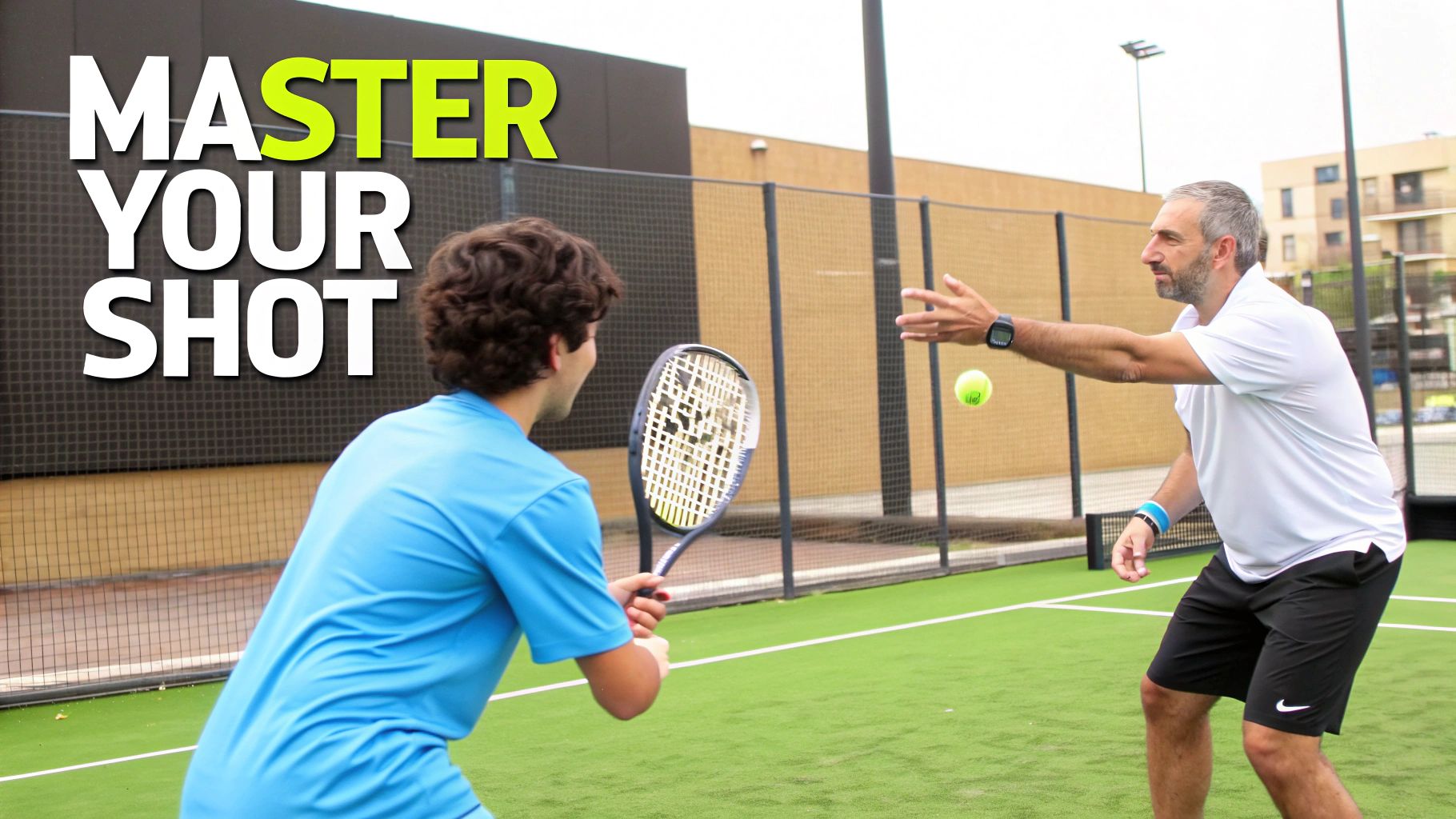
When you're just starting your padel journey, you’re going to have questions. Everyone does! This sport is exploding in popularity, and with its own unique rules and quirks, there's a bit of a learning curve. To help you out, we've put together some answers to the questions we hear all the time from new players.
Getting these basics down will do more than just help you play better; it'll give you the confidence to get on the court and avoid those classic rookie mistakes. Think of this as your personal FAQ to get you playing and having fun, fast.
Is Padel Really Easier To Learn Than Tennis?
Absolutely. For most people, padel is significantly easier to get the hang of than tennis. The court is much smaller, so you aren't covering nearly as much ground. The biggest difference, though, is the serve—it's underhand, which is incredibly simple to learn and gets you into a real rally from day one.
The racket helps, too. It’s solid and has a short handle, making it way easier to control than a long, stringed tennis racket. Plus, with the glass walls keeping the ball in play, rallies last longer, which means more fun and less time spent chasing stray balls. This gentle learning curve is a huge reason padel is so popular; you feel like you're actually playing the game your first time out.
What Is The Biggest Mistake New Players Make?
Without a doubt, it's trying to hit the ball too hard. I see it all the time, especially with players coming from a tennis background where power is king. It’s a natural instinct, but in padel, strategy almost always wins over brute force.
Because the court is so small and enclosed, just blasting the ball with all your might usually sends it flying off the back glass unpredictably. More often than not, this just sets your opponent up for an easy smash.
The key shift in mindset is to focus on control and placement over raw power. Aim for specific spots, use the walls as your ally, and learn to be patient. In padel, a well-placed soft shot is often more deadly than a blistering fastball.
Do I Need A Partner To Play Padel?
Even though padel is strictly a doubles game, you definitely don't need to show up with a partner to play. This is one of the best things about the sport—it's incredibly social.
Almost every padel club or booking app has a system for matching players up. You can join "mix-in" sessions, sign up for an open spot in a game, or get automatically paired with three other players around your skill level. It’s a core part of the padel culture and makes it super easy to find a game anytime and meet new people.
Can I Just Wear My Tennis Shoes For Padel?
For your first game or two, sure, your tennis shoes will get the job done. But if you plan on playing regularly, one of the smartest things you can do is buy a pair of proper padel shoes.
Padel courts, usually made of artificial turf with a bit of sand, demand a very specific kind of grip. Padel shoes have soles designed for this surface, often with a herringbone or mixed pattern that’s perfect for the quick pivots and side-to-side movements of the game. They don't just help you play better; they're crucial for preventing ankle and knee injuries.
At Padel Rumors, we're committed to being your ultimate resource for everything padel. From in-depth gear reviews and guides to the latest tournament news, we've got you covered. Explore our site to improve your game and join the global padel community. Discover more at https://padelrumors.pages.dev.


